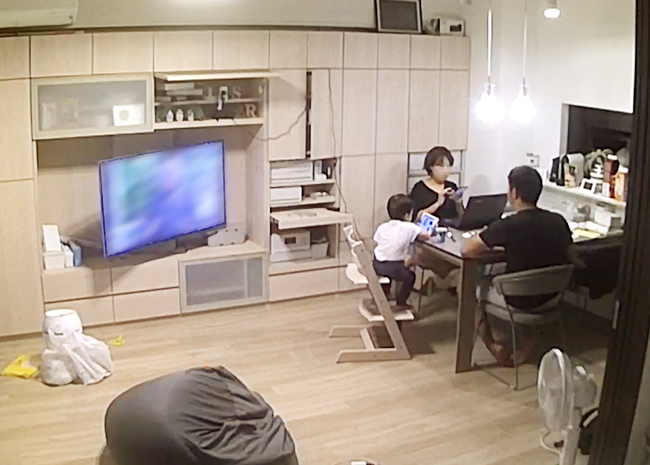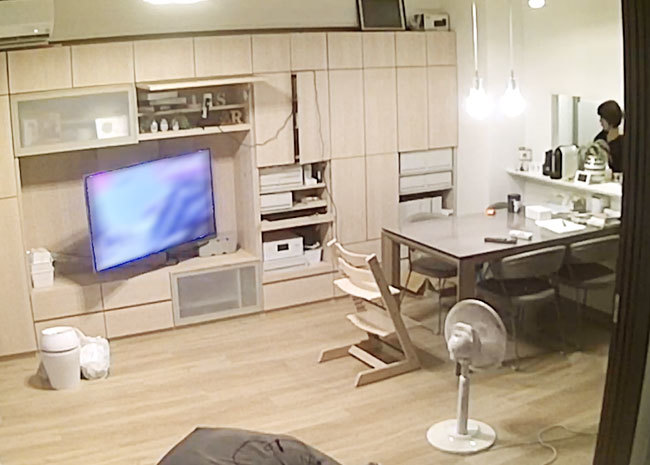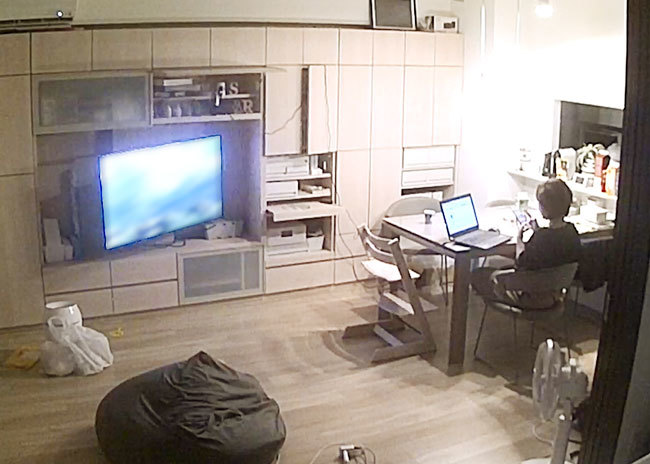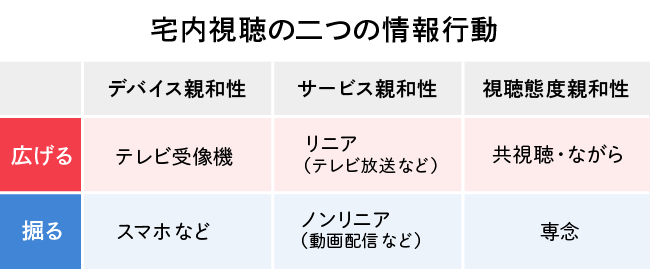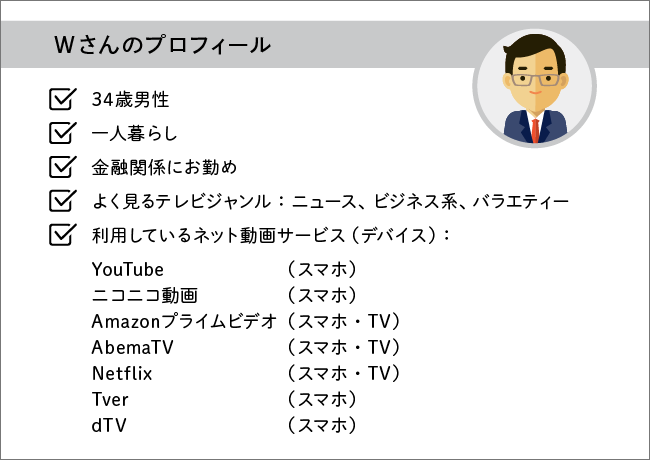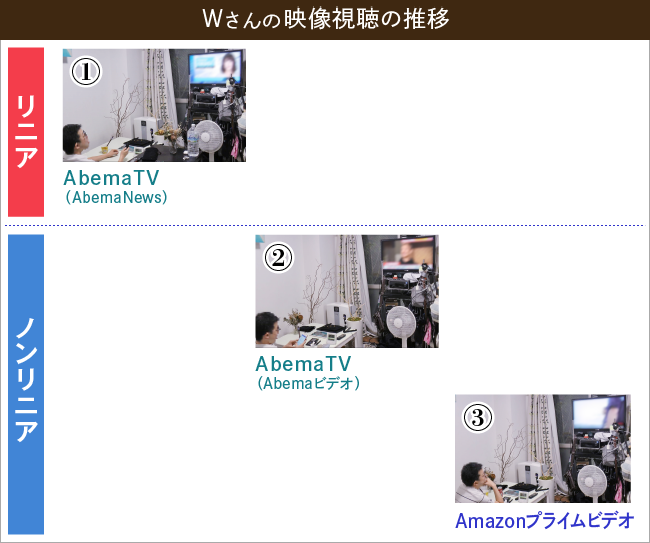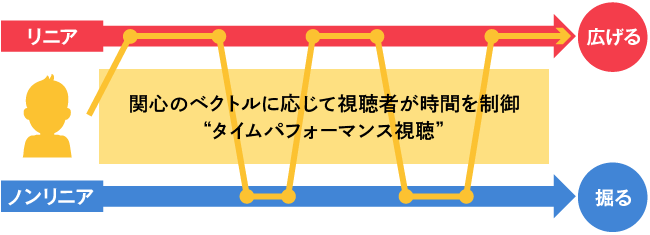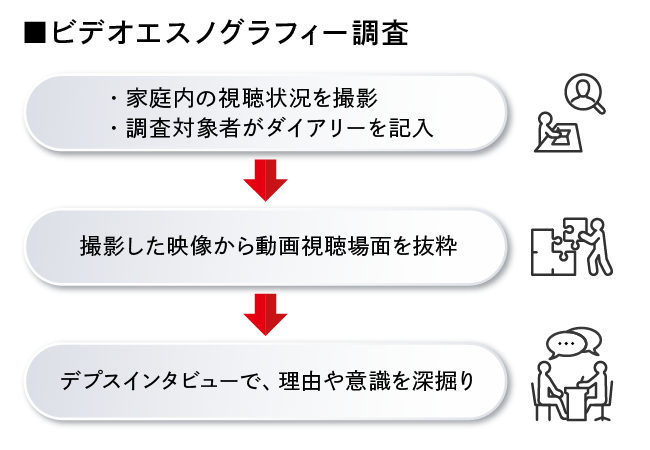Last time, we revealed the reality of "time-performance viewing" (Taipa viewing), where viewers pursue maximizing their "satisfaction with disposable time (time they can freely use at their own discretion)."
This time, we analyze the results of a video ethnography study (conducted by installing cameras in the homes of consenting participants) jointly conducted by Video Research Ltd. and Dentsu Inc. We examine how television and smartphones, as well as linear services (such as broadcast TV, where content is viewed according to a predetermined schedule) and non-linear services (such as VOD, where content is delivered based on viewer demand), are used within the home.
Exploring Linear/Non-Linear Usage in TV-Loving Households
Ms. A grew up in a home where the TV was constantly on since childhood. Even now, she keeps the TV on continuously while at home. Her video viewing time reaches 482.3 minutes on weekdays and 518.0 minutes on holidays.
While live broadcasts (linear) form the core of his TV viewing, he also frequently uses computers and smartphones, watching non-linear videos like YouTube and Niconico Douga on his phone. This household seems ideal for observing how linear and non-linear services are differentiated.
■Television Excels at Sharing Interests with Others
At Mr. A's home, the TV is built into the living room furniture, allowing for relaxed viewing while lying on the floor. The screen can also be swiveled sideways for viewing from the dining table or kitchen.
Observing how Mr. A uses the TV, the frequent scenes of family members watching together stood out.
Photo 1
Photo 1 shows a scene after dinner at Mr. A's home, with the TV broadcast playing continuously. However, not everyone is focused on the TV: Mr. A is on his computer, his husband is eating while watching TV, and his son is using a tablet.
Why keep the TV on when all three are doing separate things? According to Ms. A, "Without the TV sound, it gets too quiet, making conversation awkward," and "The TV provides conversation starters or cues." This reveals they expect the TV to act as a lubricant for family interaction.
In the survey footage, a scene was observed where the husband, after seeing news about a cabinet reshuffle, spoke to Ms. A. In this survey, scenes where the TV served as a catalyst for conversations with family or friends were observed not only with Ms. A but also with other participants.
Linear services, represented by television broadcasts viewed on large screens, are highly compatible with shared viewing experiences. They possess the efficacy of sharing interests with others and expanding communication.
■TV "Broadens" Interests, Smartphones "Dig" into Them
Although Mr. A keeps the TV on constantly while at home, he doesn't necessarily watch programs the entire time. The longest viewing period actually seems to be during multitasking—watching TV while doing household chores.
Photo 2
Photo 2 shows Ms. A watching the TV in the living room while cooking in the kitchen. She explains that during this time, she "kind of listens with her ears" and "for news or variety shows, she can follow the flow just by listening. If an interesting news item comes on, she glances at the TV screen."
A similar phenomenon was observed during commercials. She shared an experience where she heard a brand name mentioned alongside a favorite celebrity's name and instinctively checked it out.
Observing Mr. A's viewing behavior suggests that "multitasking" and "focused attention" are not mutually exclusive; rather, they seem to switch seamlessly based on auditory cues.
In fact, it even seemed that during multitasking viewing, receptivity to unexpected external information was higher than when focused solely on specific content.
"Multitasking" isn't a term the advertising industry, which wants viewers to watch commercials more attentively, uses in a particularly positive light. However, we believe "multitasking" viewing—where TV audio serves as a trigger, creating a foundation for people to encounter new information—deserves renewed attention.
■Smartphones and PCs: Ideal for Digging into Personal Interests
In Mr. A's daily life, viewing while using a smartphone or computer alongside the TV—so-called "double-screen" or "triple-screen" viewing—appears to be the norm.
Photo 3
Photo 3 shows a "triple screen" scenario where TV is on while also using a smartphone and computer. At this moment, Person A is engrossed in online shopping, with minimal awareness of the TV.
In this state, they might not even notice commercials airing, and they also mentioned not skipping commercials even when watching recorded playback.
While the television receiver remains open to external information through "conversation" and "multitasking," the information devices at hand (smartphones, tablets, computers) are used less for accepting external information and more for focusing on personal interests, digging deeper and deeper into information inward.
■Two Information Behaviors Observed in Home Viewing
Observing Mr. A's case reveals two major types of information behaviors coexisting in home viewing.
One type represents information behaviors like family "co-viewing" or "multi-tasking viewing" during household chores. Characterized by not having a specific information-gathering goal and being open to incoming external information, this can be described as an information behavior that "broadens" the viewer's interest outward. It is thought to be highly compatible with linear services like broadcasts primarily viewed on television sets.
The other type involves individual information-seeking behavior focused on exploring specific content. This behavior concentrates on immediate interests and engages less with incoming external information, essentially "digging" interest inward. It is highly compatible with individually controlled information devices like smartphones and non-linear services such as SVOD and video sharing platforms.
※Please also refer to the first installment of this series for an overview.
"Expanding" and "Digging" represent information behaviors that became apparent as smartphones and other information devices were added to the traditional TV-centered home viewing experience. Without understanding how consumers actually differentiate between these two information behaviors within the home, it seems impossible to consider future home viewing behavior.
Viewers transitioning between "Expanding" and "Digging" within the TV set
While in Mr. A's case, "Expanding" and "Digging" appear as distinct uses of the TV set and information devices, some consumers transition between these behaviors within the same TV set.
Let's revisit Mr. W, introduced in Part 2.
Mr. W is a single man in his 30s. He uses his television set not only for broadcast TV but also for video services like AbemaTV and Amazon Prime Video. His viewing habits are characterized by a diverse mix of linear broadcasts and both linear and non-linear video streaming content accessed through his television set.
Figure 4
Figure 4 shows how Mr. W, on a weekend evening, started watching a news program (linear) on AbemaTV via his TV set, then switched to Abema Video (non-linear) on the same AbemaTV platform, and subsequently moved on to Amazon Prime Video (non-linear).
Weekend television broadcasts feature many variety shows. For Mr. W, whose job involves financial product sales and who wants to stay informed about a wide range of news, AbemaTV, which continuously streams news, is a convenient resource. It appears that Mr. W perceives AbemaTV, while being a video streaming service, also has aspects of a linear service that streams according to a schedule, much like traditional television broadcasts.
After watching news programs on AbemaTV for a while, W then switched to Abema Video (non-linear) within the same platform. This service allows unlimited access to missed content, and W selected and watched a talk show (Figure 4②).
According to W, they had watched the program once on their smartphone and found it interesting, so they decided to watch it again on a TV screen. This viewing behavior is unique to AbemaTV, where linear and non-linear services coexist within the same platform.
After watching another program on Abema Video, he then moved to Amazon Prime Video (Figure 4③).
On Amazon Prime Video, he selects a documentary program and watches it intently until bedtime.
■The Era Where Viewers Control the Flow of Time
What's noteworthy in Mr. W's case is how he freely crosses between linear and non-linear content on his TV set, based on his interests at that moment.
From the perspective of "time performance viewing" (Taipa viewing), for Mr. W, there is no inherent superiority between broadcast or video streaming, linear or non-linear. He simply uses "broadening" and "digging deeper" to maximize his "time performance" at that moment.
In essence, he unconsciously edits his own timetable by traversing linear and non-linear content. "Time Performance Viewing" (Taipa Viewing) may represent the actual shift in control over viewing time within the home, moving from service providers to viewers.
Video service viewing on TV screens will continue to expand, centered around non-linear services like SVOD. Meanwhile, existing broadcast services (linear) are also gaining new possibilities through catch-up services and simultaneous online streaming.
Viewers seeking "time performance" are increasingly blending linear and non-linear service formats, and transcending device boundaries like TV and smartphones, strategically "expanding" and "digging deeper" into content. This era demands a rethinking of how we design viewing environments for such audiences.
<Notes>
【Survey Overview】
●Research Method:
Observation via home video recording (video ethnography) and in-depth interviews
(Video cameras installed in participants' homes to record two days of TV viewing behavior; interviews conducted later while reviewing the footage)
●Study Name: Dentsu Inc. Video Research Ltd. Joint "Full Circle TV" Study
●Target Area: Greater Tokyo Area (Tokyo and three surrounding prefectures)
●Eligibility Criteria: ・Individuals who consistently watch videos on both TV screens and smartphones
・Excluding those who never watch broadcast television
・Users of any major video service (YouTube,
Amazon Prime Video, AbemaTV, etc.)
・Frequent social media users (Instagram, Facebook, Twitter)
・Ages 20s to 40s (excluding media and market research professionals)
●Sample size: 5 individuals
● Survey period: September–November 2018
●Research organization: Video Research Ltd.


